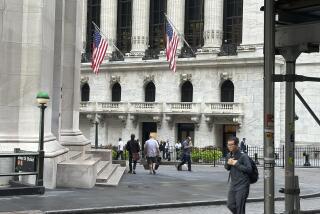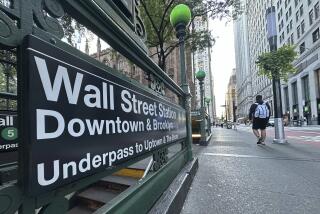Therapy for Investors Too Spooked to Move
For a bull market, this one hasn’t been much fun for a lot of investors. Even when they’re making money, most people seem wracked by anxiety over stocks’ record highs. Unsure of what happens next with the economy and interest rates, many people are afraid to buy, but they’re also afraid to sell. Yet things may not be quite as complicated as investors--and Wall Street in general--are making them out to be. Here’s a simple primer that might help clear the air a bit for investors and would-be investors on the edge:
Q: I don’t get it. People were terrified all last week about that Friday report on August unemployment. Then the report comes out, and the Dow gains all of 3.13 points to 3,011.63. Big deal.
A: Right. This is the classic market pattern in times of economic uncertainty: Hurry up and wait for the next economic indicator. Then it comes, and often the reaction is no reaction, or it’s mild at best. But Wall Street has to act this way--people always need something to worry about.
Q: Isn’t the big fear that the economy is still in recession-- ergo, you don’t want to own stocks?
A: That’s one fear. But many of the economic statistics for June and July showed a definite turnaround. You can’t look at July’s 10.7% rise in factory orders for durable goods (airplanes, machine tools, refrigerators, etc.) and say it’s just a fluke. Business is picking up for a lot of companies, though certainly not for all. Remember: Recessions don’t last forever, and we started this one a year ago. That’s a good, long shakeout.
Q: And what did the August unemployment report show?
A: The national unemployment rate was unchanged from July’s 6.8%, so plenty of people are still out of work. But you have to look deeper into the numbers. Manufacturing payrolls rose, as plants received more orders. However, employment still is dropping in such fields as construction and retail, and at the state- and local-government level.
Q: So where does that leave the stock market?
A: Well, it seems as if Wall Street is getting exactly what it prayed for earlier this year: A slow recovery led by manufacturing, which implies that foreign demand for our exports remains pretty healthy. Meanwhile, we’ve still got serious problems in the service sector of the economy, but some experts argue that employment in many service fields was bloated and inefficient anyway.
Q: Wait a minute--the service sector makes up two-thirds of the economy. If those dry cleaners, lawyers, waiters and others are out of work, how do we get a big economic recovery going?
A: We probably don’t. But if you’re looking at this solely from the selfish point of view of Wall Street, you don’t want a big recovery. Fast growth would probably mean more individuals and companies would be borrowing money, which could send interest rates up. And that would certainly not be good for stocks right now.
Q: Oh, right. We still have to worry about interest rates.
A: Actually, maybe we ought to stop worrying. All year long people have been worrying about interest rates, and mostly for nothing. Rates have bounced around, but the trend has clearly been down. We started the year with the 30-year Treasury bond at 8.24%. Now it’s at 8.01%. The average money market mutual fund yielded 7.16% at the start of the year; now it pays 5.26%.
Q: Sure, but maybe the decline is over.
A: So what if it is? If there’s nothing to make rates go up from here soon--i.e., there’s no economic boom on the horizon--at some point Wall Street’s infatuation with rates will subside and investors will start focusing on something else.
Q: Start focusing on what, for example?
A: The 1992 presidential election, the disintegration of the Democratic Party, national health insurance, Europe’s 1992 economic unification, how to feed the Soviets this winter, who’ll win the Super Bowl . . . who knows? But whatever the focus du jour happens to be, the real concern on a stock-by-stock basis is going to be each company’s profitability.
Q: Are you saying that up until now Wall Street hasn’t cared about corporate profits?
A: No, of course it has. But many people have been far more focused on interest rates. Bidding stocks up as rates fall is a natural reflex--it’s Pavlovian. Lower rates are good for the economy, and lower bond yields mean that bonds provide less competition for stocks. If rates have bottomed, however, you stop acting on reflex and starting using your brain more when picking stocks.
Q: But isn’t there a danger that as people look closer at stocks now, they won’t like what they see? Prices are high.
A: True. Yet it’s hard to imagine that people are going to start pulling away en masse from the stock market this fall, even with prices near record heights. Think about it: With the new year less than four months away, this is the time when discussion about companies’ 1992 profit prospects is going to heat up.
As portfolio strategist Steven Einhorn at Goldman, Sachs & Co. notes, when it comes to earnings, “People trade stocks on the basis of expectations, not history. . . . This is especially critical when the economy and earnings are at an inflection point.”
Q: But what if people decide profits will be lousy in ‘92?
A: They probably will, in the case of some companies. But let’s face it: It’s human nature to be optimistic, if you can be. The stock market may get spooked temporarily by some outside event in October (it’s a bad month, historically), but the end of recession means Wall Street can only figure that things will get better in 1992. Don’t forget: With war looming last year at this time, we couldn’t assume the same about 1991.
Q: It’s just so hard to decide which stocks make the most sense now.
A: Right. Wall Street will be expending lots of mental energy this fall trying to decide if the better chance for 1992 gains lies in the companies that serve consumers (food, drugs, health care, entertainment, etc.) or in the companies that supply the basic goods for the economy (metals, machinery, farm equipment, chemicals, etc.).
Q: Not that again--I hate that debate!
A: You’re not alone. So why bother getting caught up in it? You ought to have money in both types of stocks today, because there really is no way to tell which group will perform better. If you own a good mix of stocks (or stock mutual funds that invest in both consumer and industrial companies), you’ll never have the feeling that you’re missing the boat. Diversification is so basic, but people often overlook it.
Q: Well, I really want to buy stocks, because I figure the economy will continue recovering in 1992, and all I’m getting at the bank is 6% now. But I still keep thinking I’ll be able to get stocks cheaper in a few months.
A: You and a few billion other people. You may be right. Certainly, stocks have ebbed and flowed this year. But in general, the market keeps working itself higher. Take a look at the accompanying table. It shows one representative stock from the consumer group (cereal giant General Mills) and one from the industrial group (Phelps Dodge, the nation’s largest copper producer).
There have been good months and bad months for both of these stocks in 1991. Year to date, General Mills is up 29%, and Phelps is up 22%.
You’d have rather owned General Mills, of course, but Phelps still performed better than the average stock (the Standard & Poor’s 500 index is up 18%).
Point is, trying to trade stocks has been a treacherous game, because the market is so fickle from week to week and month to month. That probably won’t change anytime soon. So you’re much better off with old-fashioned investing-- buy stocks that you believe are reasonably priced, that have good profit prospects for 1992, and that you’re willing to hold at least a year or two.
The Reluctant Bull Market This is how it goes in a stock market that can’t make up its mind about the economy. Since Dec. 31 of last year, both consumer stock General Mills and industrial stock Phelps Dodge have gained more than the 18% rise in the Standard & Poor’s 500 index. But getting there has been a slow, start-and-stop process. Moral: If you stay too focused on the month-by-month gyrations of stocks--rather than the long view--you can drive yourself crazy.
Month-by month changes, 1991
General Mills Phelps Dodge Month Stock change Close Stock change Close Dec. ’90 $49 $56 5/8 Jan. -3.8% 47 1/8 +6.4% 60 1/4 Feb. +14.3% 53 7/8 +8.9% 65 5/8 March +7.2% 57 3/4 +2.3% 67 1/8 April -3.2% 55 7/8 -0.7% 66 5/8 May +5.1% 58 3/4 -1.9% 65 3/8 June -3.8% 56 1/2 -0.9% 64 3/4 July +11.5% 63 +7.3% 69 1/2 Aug +2.2% 64 3/8 +0.2% 69 5/8 Year to date +29.3% 63 3/8 +21.9% 69
More to Read
Inside the business of entertainment
The Wide Shot brings you news, analysis and insights on everything from streaming wars to production — and what it all means for the future.
You may occasionally receive promotional content from the Los Angeles Times.










